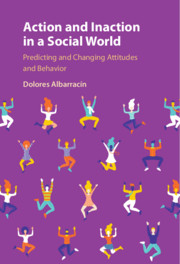Refine search
Actions for selected content:
13 results
Audi alteram partem: An experiment on selective exposure to information
-
- Journal:
- Journal of the Economic Science Association ,
- Published online by Cambridge University Press:
- 20 August 2025, pp. 1-12
-
- Article
-
- You have access
- Open access
- HTML
- Export citation
What Chinese Internet Users “Like” to Read: Selective Exposure in a Restricted Information Environment
-
- Journal:
- The China Quarterly / Volume 260 / December 2024
- Published online by Cambridge University Press:
- 26 April 2024, pp. 1059-1074
- Print publication:
- December 2024
-
- Article
- Export citation
Selective information sampling: Cognitive coherence in evaluation of a novel item
-
- Journal:
- Judgment and Decision Making / Volume 4 / Issue 4 / June 2009
- Published online by Cambridge University Press:
- 01 January 2023, pp. 307-316
-
- Article
-
- You have access
- Open access
- HTML
- Export citation
Preference-driven biases in decision makers’ information search and evaluation
-
- Journal:
- Judgment and Decision Making / Volume 8 / Issue 5 / September 2013
- Published online by Cambridge University Press:
- 01 January 2023, pp. 561-576
-
- Article
-
- You have access
- Open access
- HTML
- Export citation
Ideological and Partisan Bias in the Canadian Public
-
- Journal:
- Canadian Journal of Political Science/Revue canadienne de science politique / Volume 54 / Issue 2 / June 2021
- Published online by Cambridge University Press:
- 11 May 2021, pp. 267-291
-
- Article
-
- You have access
- HTML
- Export citation
Chapter 10 - Conclusions and Future Directions
- from Part V - Conclusion
-
- Book:
- Action and Inaction in a Social World
- Published online:
- 21 January 2021
- Print publication:
- 18 February 2021, pp 301-306
-
- Chapter
- Export citation
Chapter 1 - Definitions, Overview, Goals, and Principles of Cognitive Processing
- from Part I - Introduction
-
- Book:
- Action and Inaction in a Social World
- Published online:
- 21 January 2021
- Print publication:
- 18 February 2021, pp 3-42
-
- Chapter
- Export citation
Chapter 8 - Persuasive Communications and Behavioral Interventions in the Context of Prior Attitudes and Behaviors
- from Part IV - The Impact of Persuasive Communications and Behavioral Interventions
-
- Book:
- Action and Inaction in a Social World
- Published online:
- 21 January 2021
- Print publication:
- 18 February 2021, pp 221-272
-
- Chapter
- Export citation
Chapter 9 - Actionability, Sources of Actionability, and Behavioral Impact of Persuasive Communications and Behavioral Interventions
- from Part IV - The Impact of Persuasive Communications and Behavioral Interventions
-
- Book:
- Action and Inaction in a Social World
- Published online:
- 21 January 2021
- Print publication:
- 18 February 2021, pp 273-298
-
- Chapter
- Export citation

Action and Inaction in a Social World
- Predicting and Changing Attitudes and Behavior
-
- Published online:
- 21 January 2021
- Print publication:
- 18 February 2021
Information from Abroad: Foreign Media, Selective Exposure and Political Support in China
-
- Journal:
- British Journal of Political Science / Volume 49 / Issue 2 / April 2019
- Published online by Cambridge University Press:
- 12 April 2017, pp. 611-636
-
- Article
- Export citation
Media evolution and public understanding of climate science
-
- Journal:
- Politics and the Life Sciences / Volume 30 / Issue 2 / Fall 2011
- Published online by Cambridge University Press:
- 18 January 2016, pp. 20-30
-
- Article
- Export citation
How Does Media Choice Affect Hostile Media Perceptions? Evidence from Participant Preference Experiments
-
- Journal:
- Journal of Experimental Political Science / Volume 2 / Issue 1 / Spring 2015
- Published online by Cambridge University Press:
- 06 February 2015, pp. 12-25
-
- Article
- Export citation
